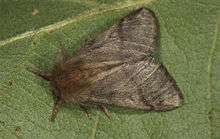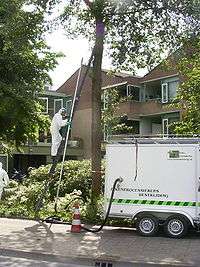Oak processionary
| Oak processionary | |
|---|---|
| | |
| Oak processionary caterpillars | |
| Scientific classification | |
| Kingdom: | Animalia |
| Phylum: | Arthropoda |
| Class: | Insecta |
| Order: | Lepidoptera |
| Family: | Thaumetopoeidae |
| Genus: | Thaumetopoea |
| Species: | T. processionea |
| Binomial name | |
| Thaumetopoea processionea Linnaeus, 1758 | |
The oak processionary (Thaumetopoea processionea) is a moth whose caterpillars can be found in oak forests. They may pose a human irritant because of their poisonous setae (hairs), which may cause skin irritation and asthma.
Distribution
The moths are widely distributed in central and southern Europe, and are occasionally found as far north as Sweden. In the southern countries of Europe the populations are controlled by natural predators, but these predators do not exist in northern Europe. Their range is expanding northward, possibly or partly as a result of global warming. The moth now has an established population in the UK. The eggs arrived on oak imported to the Richmond and Ealing areas of London in 2006 [1] and the range of the species in the UK has been steadily expanding despite efforts to eradicate it. In 2013 the Forestry Commission announced helicopters would be deployed to "blanket spray woodland" where the caterpillars posed a health threat.[2]
Description

The wingspan of adult stage moths is between 25 and 35 millimetres (0.98 and 1.38 in). Their pattern of tan, brown and white make the adults difficult to see against oak bark. Adults fly during July and August. The larvae construct communal nests of white silk from which they crawl at night in single file, head to tail in large processions to feed on foliage in the crowns of trees, returning in the same manner.
Oak is its preferred food source, but the moth also eats the leaves of hazel, hornbeam, sweet chestnut, birch and beech.[3]
Public health problem

The moths pose an increasing threat to humans as their range is extended. The backs of older caterpillars (3rd to 6th instars) are covered with up to 63,000 pointed defensive bristles containing an urticating toxin (thaumetopoein or closely related compounds). The setae break off readily, become airborne and can cause epidemic caterpillar dermatitis (lepidopterism), manifested as a papular rash, pruritus, conjunctivitis and, if inhaled, pharyngitis and respiratory distress, including asthma or even anaphylaxis. However, there have been no known deaths related to or caused by such exposures to this toxin.
It has been found that the skin irritation itching effects of contact with these hairs can be largely eliminated by the use of cetirizine-based antihistamines in tablet form. Typical commercially available preparations include "Zyrtec".
Transmission of the hairs can be airborne, by ground contact via plants or grass or even by water contact in stillwater e.g. garden ponds. The toxicity of the hairs remains active beyond the normal life cycle of the moth and in some cases can remain a problem for several seasons.
With regard to lawn maintenance, normal grass cutting removal techniques can bring the individual into contact with these hairs. One alternative is to adopt a grass mulching technique to reduce possible contact and furthermore speed up the biological breakdown of the irritant hairs into the soil.
Control

England
Infestations of this caterpillar were first found in several locations in London in 2006. The general public have been asked to look out for these caterpillars and to report them, rather than deal with them themselves. The London Boroughs of Brent, Ealing, Hounslow and Richmond upon Thames have set up task forces to deal with outbreaks. Sightings of these caterpillars in other areas should be reported to the Forestry Commission.[4] The research agency of the Forestry Commission has issued guidance on the way to contain outbreaks and deal with infestations, so as not to increase the risk to the public.[5]
An emergency amendment came into force on 31 March 2008, which added the moth to the list of pests in The Plant Health (Forestry) Order 2005, and requires all oak trees coming into the UK from the rest of Europe to have Plant Passports.[6]
Belgium
In 2007 infestations in the Belgian province of Limburg were so acute that soldiers were deployed to burn them.
See also
- Lonomia obliqua, poisonous caterpillar of Brazil
References
- ↑
- ↑ Helen Dixon (7 May 2013). "Helicopters to spray woodland to halt march of toxic caterpillars". Daily Telegraph. Retrieved 7 May 2013.
- ↑ Tree News, Autumn/Winter 2007, page 4 internal Sylva supplement
- ↑ The Forestry Commission. Oak processionary moth. Accessed 2008-05-31
- ↑ Forest Research Survey and intervention in relation to different phases of the oak processionary moth life cycle. Accessed 2008-05-31
- ↑ Office of Public Sector Information. Explanatory memorandum to the Plant Health (Forestry) (Amendment) Order 2008 No. 644. Accessed 2008-05-31
- Maier, H.; Spiegel, W.; Kinaciyan, T.; Krehan, H.; Cabaj, A.; Schopf, A.; Honigsmann, H. (24 November 2003). "The oak processionary caterpillar as the cause of an epidemic airborne disease: survey and analysis". British Journal of Dermatology 149 (5): 990–997. doi:10.1111/j.1365-2133.2003.05673.x.
- Rahlenbeck, S.; Utikal, J. (1 August 2015). "The oak processionary moth: a new health hazard?". British Journal of General Practice 65 (637): 435–436. doi:10.3399/bjgp.15X686341.
External links
| Wikimedia Commons has media related to Oak processionary. |
- Moths and Butterflies of Europe and North Africa (with photos of larvae and adults)
- Forestry Commission: oak processionary Moth
- Life-cycle, risks and treatments
|